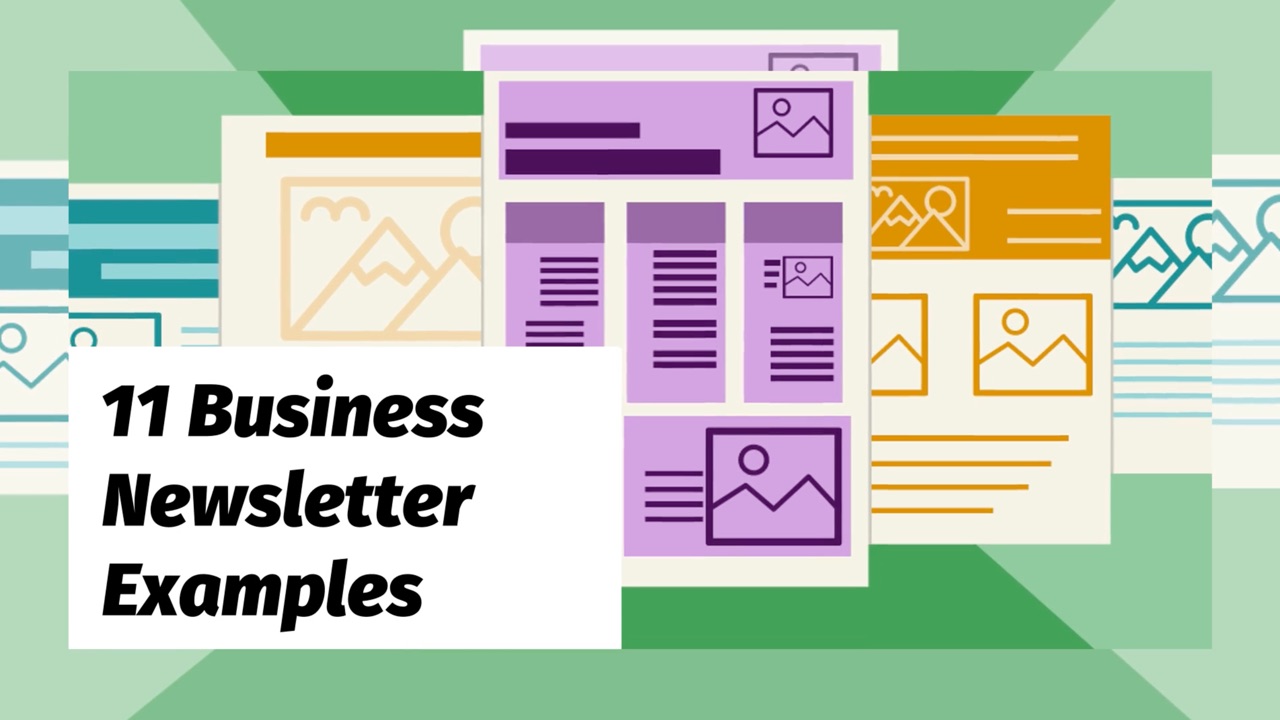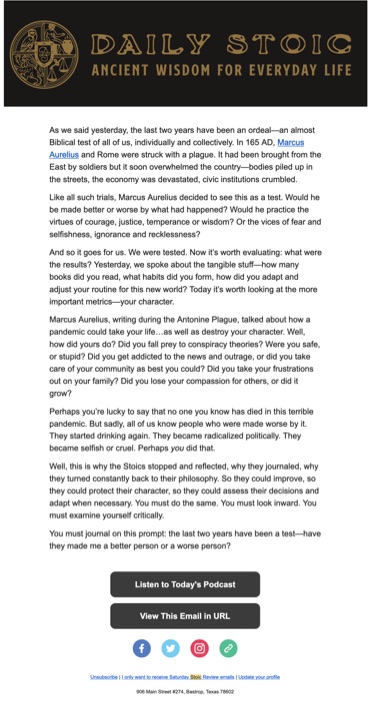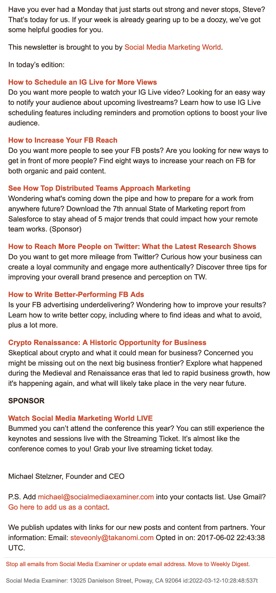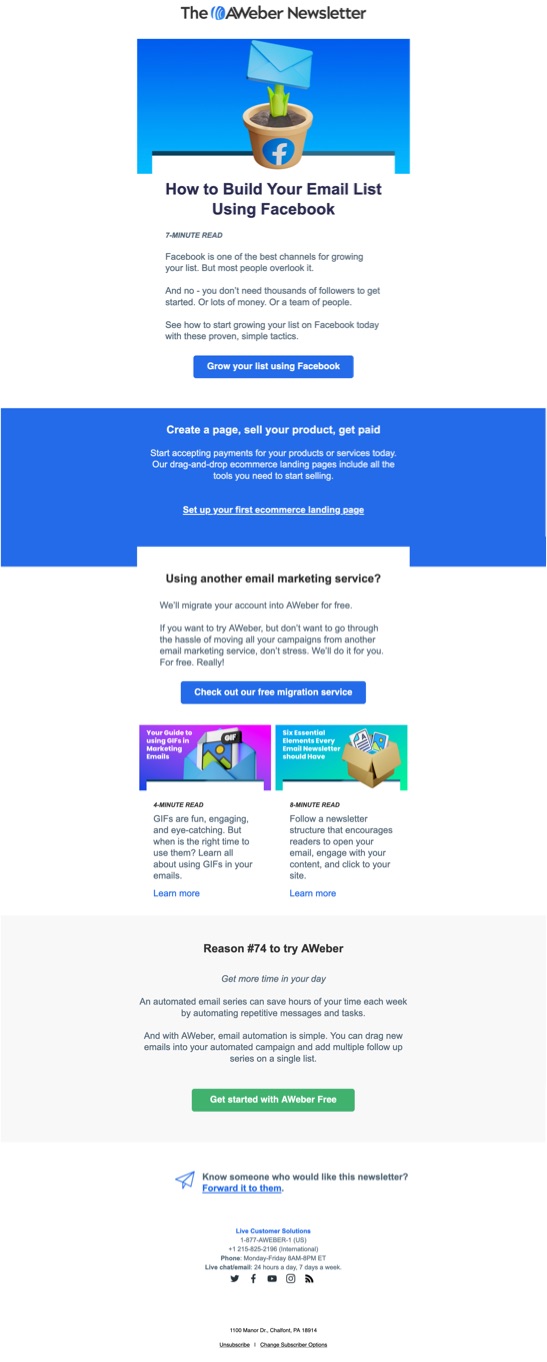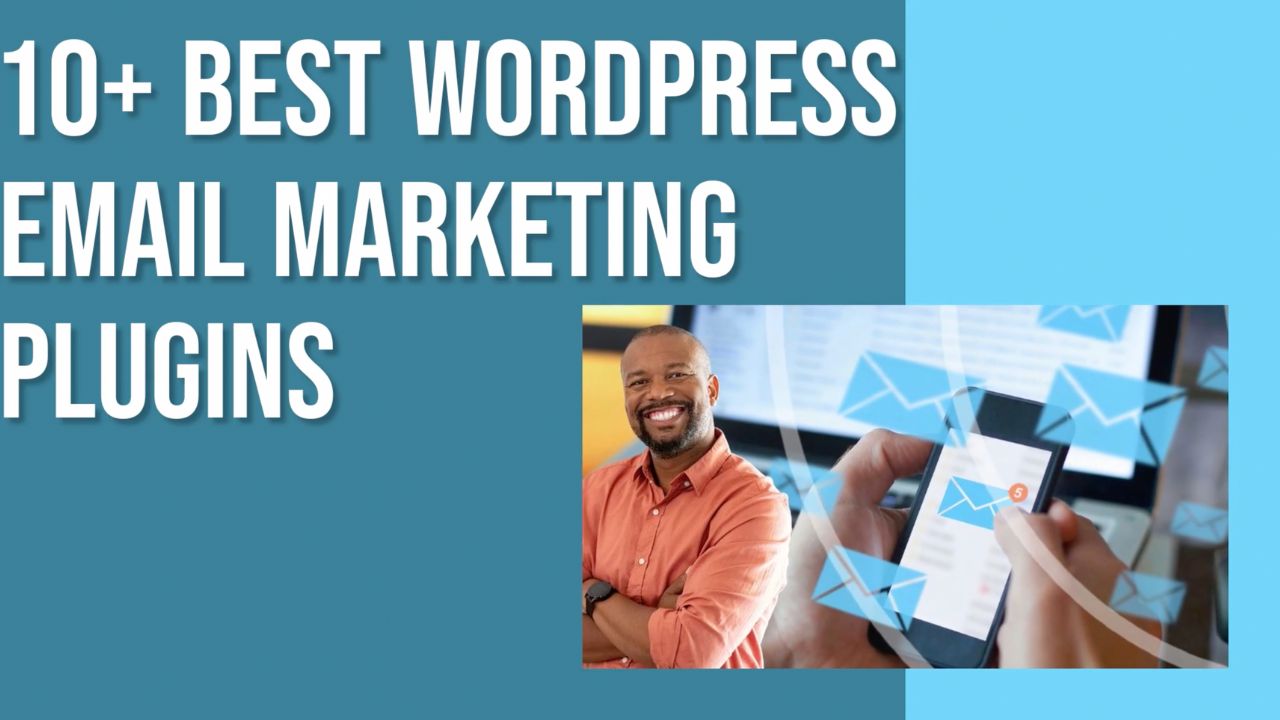Thinking of starting a business newsletter?
Looking for some inspiring examples to model your own on?
(Or maybe you’ve already got one that needs a bit of a revamp?)
Below you'll find 11 real-life business newsletter examples (most with hundreds of thousands of subscribers, so you know they work!) with a wide range of approaches and styles...
11 Top Business Newsletter Examples
To be clear, there’s no ‘right’ way to create a newsletter, only what works best for:
- Your goals
- The audience you serve.
As you’ll see, some of these examples are really quite short, others a lot longer (and some a lot, lot longer!).
Some rely heavily on graphics, others barely any or none at all.
So they're all very different.
But you'll also likely spot similarities between some of them, such as:
- Social media icons linking to their relevant profiles.
- Links to regularly-created content on their blog or other content channels.
- The ability to view the newsletter via a web page, rather than solely within the email client.
For each example, click the image provided to see a larger version.
(Please note that all content remains copyright of the respective businesses, and we’d encourage you to subscribe directly to those of interest via the links provided so that you can see the newsletter for real in your inbox).
1. Daily Stoic
The Daily Stoic newsletter from top author Ryan Holiday (Stillness Is The Key, The Obstacle Is The Way, and others) spreads Stoic philosophy, a.k.a. “Ancient Wisdom for Everyday Life”, to over 400,000 subscribers.
Behind the newsletter is a thriving ecommerce business that sells Stoic-inspired merchandise such as medallions and pendants, autographed books and courses, and offers a subscription to Daily Stoic Life, billed as “a global community of Stoic thinkers and practitioners dedicated to becoming the best versions of themselves” for a recurring yearly membership fee.
The newsletter itself, published every day except on Sundays, offers a few paragraphs of timely wisdom to help subscribers navigate through life and develop a Stoic mindset.
Links within the text of the newsletter generally go to relevant articles on DailyStoic.com or to related merchandise.
There’s also a button in the email that links to a daily podcast, which features an audio version of that day’s email.
Another button enables subscribers to view the content of the email on the website, and social buttons link to the Daily Stoic’s profiles on Facebook, X and Instagram.
2. Content Marketing Institute
The Content Marketing Institute has over 200,000 subscribers, mostly content marketing professionals, and generally publishes a newsletter every working day.
Each edition generally contains an article that links through to their blog, along with a sponsor message, and then various links in the footer for their events and resources that may be of interest to subscribers.
At the very top of each newsletter is the ability to view the same message via a browser, and in the upper right-hand corner, links to their social profiles on X, LinkedIn, Facebook and Instagram.
Most business newsletters contain link(s) to regularly-created content on their blog or other content channels. In other words, regularly-created content assists regular communication.Click To Post On3. Social Media Examiner
As you can see below, Social Media Examiner’s newsletter is relatively unusual in that there are no graphics within the email, not even for a header or adjacent to any sponsor message.
Notice too there are no links to social media profiles, instead generally directing traffic either to their own website, to content on YouTube or to their podcast.
Around half of the issues have the following format, focused on providing short descriptions of and links to several recent articles on their blog, plus an ad at the bottom.
Most of the rest of their emails are in a similar format, but rather than linking to their blog, links to their YouTube or podcast content.
They also send other occasional messages that may contain say a sponsor message, a survey or some information about an event they’re promoting.
Social Media Examiner generally publishes every two or three days, though occasionally there is a longer gap between issues.
A link at the very bottom enables subscribers to switch to a weekly digest if they’d prefer.
4. Ted Rubin Straight Talk Newsletter
Ted Rubin is a “leading Social Marketing Strategist, International Keynote Speaker, Business Advisor and… Author, Connector, Provocateur”.
He’s been listed as #13 on Forbes Top 50 Social Media Power Influencers, number #2 on the Leadtail list of Top 25 People Most Mentioned by digital marketers, and for listed in the leadersHum Global Power list of the Top 200 Biggest Voices In Leadership.
He publishes his Straight Talk Newsletter, focused on his Return on Relationship (ROR, #RonR) philosophy, on a (mostly) weekly basis.
Most issues feature an opinion piece from his blog—published in full within the newsletter—a recommended book relating to becoming “a better leader and human”, and some links to other content and resources towards the bottom.
He also includes links to his social profiles on X, Facebook and Instagram.
There’s also a link right at the top to view the newsletter in a browser.
5. Product Hunt Daily
Product Hunt is a popular site for tech products—mainly apps—that’s frequented by tech enthusiasts, founders, developers and entrepreneurs.
Listing products on the site can, when approached in the right way, provide a lot of exposure including new users and customers, as well as useful feedback and support from the community.
The site publishes a relatively lengthy daily newsletter, barring weekends, that usually features:
- An article at the top about some recent products.
- A sub-article about a specific product.
- A link to a longer article on their website.
- A listing of some of the most popular products from the day before.
- A short piece at the end with some brief info about some popular apps and related products.
The purpose is largely to provide as much exposure as possible about the products listed on their site in a format designed to engage and interest their subscribers.
A link at the top right links to a version of the newsletter on the web, alongside links to the Facebook and X profiles.
At the very bottom, they also provide a button that links to a survey enabling subscribers to leave their feedback.
6. The AWeber Newsletter
AWeber generally publishes their newsletter once a week, with the occasional additional email.
The format changes a little between issues but generally looks something like the following and tends to include:
- A short excerpt from a recent blog post along with a link
- An offer that usually relates in some way to their service—so it might be a webinar invite or some other opportunity to learn about how AWeber can help.
- Links to other content on their blog, or sometimes from their YouTube channel.
- A ‘reason to use Aweber’, consisting of a short paragraph and a link to start using their email campaign service.
At the very bottom, they include links to their profiles on X, Facebook, YouTube and Instagram, and a link to the RSS feed for their blog.
7. MarketingProfs Today
MarketingProfs is “a rich and trusted resource that offers actionable know-how to help you market your products and services both smarter and better”, with 600,000 subscribers made up of entrepreneurs, small business owners and marketers.
They generally publish three times a week, with the format including:
- A table of contents.
- Short descriptions and links to two or three articles on their blog or published research.
- Two or three sponsor messages.
- A community news section that generally features ways in which MarketingProfs can help, with links to relevant resources.
- Other links to MarketingProfs content.
- Relevant industry news with links to other sites.
- Information about upcoming events.
Yes, there’s a lot in there—as you can see, their newsletter is longer than most!
The colored box at the bottom contains:
- A link for subscribers to refer a friend to the newsletter, with various rewards available depending on the number of referrals you send them.
- Links to their profiles on Facebook, LinkedIn and X.
8. The Brief (American Express)
American Express publishes a regular weekly business newsletter called The Brief.
It provides:
- Links to articles related to business topics such as leadership or finance on their blog (like this example).
- A trivia question (with the answer provided at the end of the newsletter).
- Often a link to some video content on their website related to business leadership, or sometimes a quote or a link to some other relevant article(s) on other authority websites.
- Links to content category pages on their blog.
In the footer, they then have a button for subscribers to share the email with others. This links to a simple form with spaces to provide names and email addresses, along with a message.
Finally, there are links to their social media profiles on Facebook, LinkedIn, X and Instagram.
9. DigitalMarketer Insider
DigitalMarketer Insider (from DigitalMarketer.com) has been publishing on a weekly basis for around a couple years or so, and aims to provide “(at least) five timely, tactical marketing ideas” to subscribers.
A typical issue contains links to content on either DigitalMarketer.com or a related website, whether that’s a blog post or a link to audio or video content.
For the latter, rather than linking to YouTube or a third-party website relating to their podcast, they link to a page on their blog with the content embedded.
This provides various marketing advantages, such as being able to remarket to people who have shown an interest in a particular topic area.
In the footer, they have:
- A way for subscribers to provide quick feedback via emojis for ‘thumbs up’, ’thumbs down’ or somewhere in between - these link to a quick Google Forms feedback form.
- Links to sign up for their Lab product, or to become a certified partner.
- Links to their social profiles on Facebook, X, LinkedIn or Instagram.
There’s also a forward to a friend link in the footer, which links to a page, like American Express above, where subscribers can input the names and email addresses of people along with a message.
10. Wordtracker
Wordtracker’s newsletter, published weekly, has a ‘short and sweet’ format, containing just the following:
- Links and a brief blurb for three articles on their blog.
- A couple of ads for their keyword research service.
At the bottom, they have links to their profiles on Facebook, X, LinkedIn, Google+ (now outdated!) and Pinterest.
That’s it.
They’ve had the same format for years, so I guess it works well for them!
When creating a business newsletter to keep in regular touch with prospects, there is a multitude of different approaches available, including styles and publishing frequency.#emailmarketingClick To Post On11. Harry’s Take
Our final example of a business newsletter is from finance forecasting expert and author, Harry Dent, whose theories are based on historical cycles such as demographics and what that means for economies.
He publishes several times a week with different types of content including:
- Harry’s Take, as shown below, which provides Harry’s thoughts about current economics, generally once a week.
- Rodney’s Take, which is similar but from his business partner, Rodney Johnson, again publishing generally once a week.
- Harry’s Rant, linking to a video on his YouTube channel, publishing every week.
- Their own marketing emails.
- Third-party sponsored messages that appeal to a similar demographic.
The format for Harry’s Take (and similarly, Rodney’s Take) is largely as shown above, so long form mainly text-based content, with graphics such as charts where relevant, purely providing value and information within the email itself (rather than linking to a blog). There’s usually a brief ad somewhere.
Other emails are similar.
Thinking about creating a business newsletter? Don't wait for it to be perfect. Just start with something, and let it evolve over time.Click To Post OnFrequently Asked Questions
What is the purpose of a business newsletter?
To communicate with subscribers, provide valuable content, and promote products or services.
How can I improve my business newsletter?
Consider the preferences of your audience, vary content length and style, include links to relevant articles or products, and create engaging visuals.
Why are social media icons important in a business newsletter?
Social media icons help subscribers connect with your brand across different platforms and increase your online presence.
How often should I send out a business newsletter?
The frequency can vary but aim for consistency, whether it's daily, weekly, or bi-weekly, to keep your audience engaged.
To Conclude
Use these 11 different examples of business newsletters to inspire ideas for your own.
As we’ve seen, there is a multitude of different styles used and ways to approach it, such as long graphic-heavy emails, and shorter, mainly text-based emails.
It’s okay to experiment too. Most newsletters, including those shown here, evolve their approach over time to suit their goals and the needs of their audience, and may have started out looking very different. Start with something, and then adjust as needed.
